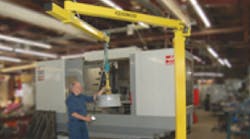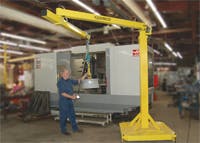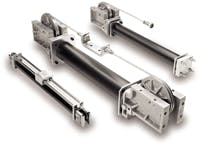In today’s manufacturing environments, employers must adhere to strict government regulations that limit the weight and reach of workers. So when an operation requires lifting and manipulating heavy payloads, workers often turn to articulated arms (jibs) for assistance. These arms not only help ensure worker safety and prevent injury, but they increase productivity because a single worker can perform tasks that otherwise would require two or more workers.
The Conco brand Articulated Jib Lifter (AJL) is a machine that is designed to function as an integrated articulated jib and balancer. Manufactured by Positech Corp., Laurens, Iowa, the AJL offers the flexibility of a balancer, even when little headroom exists. The reach-in capability, coupled with the lift and load ranges of the Conco AJL, make it a versatile, yet cost-effective material handling solution.
The Conco AJL is also a low-cost solution for material handling applications requiring lift and reach. It can be used with many hook-hung tooling options and can also be used to handle products directly with the hook.
Cable cylinder provides lift
Integrating a lift into the articulated jib arm provides additional overhead clearance and increases available reach. The lift also functions as a balancer, which provides additional functionality. This includes a load-sensing circuit to prevent accidental release of product being held by tooling; tool and payload balance circuits; and an up-and-down metering control.
The AJL uses an integrated pneumatic cable cylinder to provide a lift function. The lift cylinder is a single-acting Tolomatic cable cylinder that has been integrated into the outer arm of the machine. Routing compressed air to the retract side of the cable cylinder causes the payload to be lifted. Bleeding air from the cylinder allows the payload to be slowly and safely lowered.
A smart update in design
The current design is an update to Positech’s first version, which used a double-acting, rod-type cylinder and 2:1 pulley arrangement to double the stroke of the cylinder. This design required considerable assembly time and had quality issues with the wire rope being supported. The pulleys were difficult to adjust and align.
The challenge with the latest design was keeping the length of the outer arm short. To achieve this, a simple clamping arrangement was designed to allow the second arm to be slid forward or backward to the appropriate arm length. This then allowed the use of off-the-shelf components, which in turn, reduced the number of parts and assembly time.
The existing Articulated Jib (AJ) family was used for basic elements of this new product and shares much of its base design. This allows retrofitting the AJL’s outer arm onto any existing Conco AJ. Furthermore, optional accessories available on other Conco Articulated Jibs may also be used on the new AJL.
Because it now uses a single-acting cable cylinder, the updated version contains fewer parts and allows more off-the-shelf parts to be used. “The new design is extremely easy to repair as compared to the original design because the entire balancer can be replaced simply by removing a couple of bolts and air fittings,” explains Ben Storms, engineering manager at Positech. “Like the first design, a special second (outer) arm with a built-in balancer was designed so it could work directly with the AJ’s inner arm.”
Pneumatics provide control
The lift can be operated with a thumb-activated metering valve or as a balance lift for zero gravity. An operator can lift payload by using a metered or balanced circuit and manually float the object in the horizontal plane to the set down position. With optional tooling, payloads can be gripped, pitched, rolled, etc.
In addition, an optional safety circuit can sense cylinder pressure in a loaded and unloaded condition. The Positech Gripper Safety Circuit (GSC) option is designed to prevent accidental release of a load. When a payload is gripped and lifted, an increase in lift pressure due to the payload’s weight is sensed by the GSC, which in turn disables the release control. This effectively keeps the operator from accidentally releasing the payload until it is properly supported. Once the payload is properly supported, the lift pressure will decrease to a level at or below the empty tool weight sensed by the GSC. The release control is then re-enabled.
This feature is accomplished using pneumatic logic — no electronic controls or pressure transducers are required. However, even though electronic controls are not required for the basic functions of the manipulator, electronics can be incorporated to accommodate integrated tooling.
Pneumatics technology makes it easy to control float and balance simply by monitoring and controlling pressure. In addition, the pneumatics solution is less expensive than its electromechanical counterpart. Using the cable cylinder integrated into the outer arm of the jib, Positech is able to package up
to 120 in. of travel in a 130-in. reach arm.
Technical information for this article was provided by Ben Storms, engineering manager at Positech Corp. For more information, visit www.positech.com.
For information on Tolomatic’s cable cylinders, visit www.tolomatic.com.
| We cover pneumatics in every issue, and we archive every technical article. So if you’re looking for anything pneumatic (including air logic), check out our website, where thousands of pages of information are organized in our Technology Zones, Industry Zones, Fluid Power Basics, or just enter a key word into our search window. |



